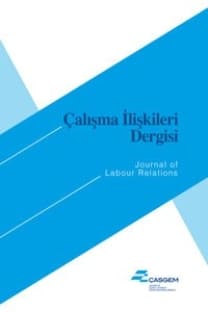Türkiye İmalat Sanayinde Büyüme ve Büyümenin İstihdam Yoğunluğu: 1980 - 2008 Dönemi
Türkiye’de özellikle son on yıldır önemli sayılacak büyüme oranları yakalandığı halde işsizliğin artması, istihdam yaratmayan büyüme olgusunu tartışmaya açmıştır. Bu makalenin amacı büyümenin gerçekten böyle bir özellik taşıyıp taşımadığını ampirik verileri analiz ederek ortaya koymaktır. Bu çerçevede, çalışma Türkiye ekonomisinde genelde temel sektörlerin, özelde ise imalat sanayinin 1980-2008 dönemindeki üretim, istihdam, üretkenlik ve ücretlerdeki eğilimlerini analiz etmektedir. Böylelikle sektörlerdeki reel katma değer artışlarının istihdam yoğunluğu irdelenmeye çalışılmaktadır. Çıktı veya katma değer artışlarının istihdam yoğunluğu “istihdam esnekliği” ile ölçülmektedir. Çalışmada istihdam esnekliğini belirleyen önemli unsurları içinde barındıran bir ayrıştırma yöntemi kullanılmıştır. Buna göre, istihdam esnekliğini yaratılan katma değerin istihdam artışı ile ücret artışı arasındaki paylaşımı önemli ölçüde etkilemektedir. Yaratılan katma değerin ücretlere ayrılan payının asıl belirleyicisi ücretlerin, çıktı esnekliği ve üretici fiyatları ile tüketici fiyatlarının göreli artış oranıdır. Kullanılan ayrıştırma yöntemi bu unsurların göreli öneminin ortaya konulmasına olanak vermektedir. Bu ayrıştırmaya dayanarak yapılan ampirik analizlerde, Türkiye imalat sanayinde 2003-2008 yılları arasında önemli oranda üretim artışlarının gerçekleştiği, fakat üretkenlik ve istihdamda görece küçük artışların yaşandığını göstermekte, bu da gelecekte büyümenin sürdürülebilirliğini güçleştirmektedir. Bu durum imalat sanayinin teknolojiye değil, düşük ücrete dayalı rekabeti sürdürmesinin bir sonucu olarak ele alınmalıdır.
Anahtar Kelimeler:
Üretim, istihdam, verimlilik, istihdam esnekliği, istihdamsız büyüme.
The Employment Elasticity and Growth in Manufacturing of Turkey: 1980 - 2008 Period
Despite the outstanding growth rates of the Turkish economy in the last decade, the rise in the unemployment rates raise the debate about the notion of jobless growth. The main aim of this article is to address the validity of the jobless growth hypothesis by analyzing the data of the Turkish Economy. In this context, the study tries to examine the tendency in production, employment, productivity and real wages of the Turkish economy as a whole and the manufacturing industry in particular for the period of 1980-2008. Thereby the employment intensity of growth of real value added at the sectoral level is being analyzed. The employment intensity of growth of value added or output is measured via employment elasticity. In this study, a simple decomposition procedure which covers the major determinants of employment elasticity, is outlined and utilized. According to this decomposition, the major determinant of employment elasticity is the allocation of value added growth between employment growth and wage growth. In real terms the share of the wage bill in value added is determined by elasticity of wages with respect to output and the movements of producer prices relative to consumer prices. The decomposition method used enables us to quantify the relative importance of these factors. The empirical analysis of the data about the Turkish manufacturing industries indicates that the Turkish economy realized significant increases in production, but with only small improvements in productivity and employment during 2003-2008 Period, thus bring a threat in sustaining economic growth in the future. This situation should be taken as a result of the competitiveness of the Turkish manufacturing industries which derived from lower wages, but not from technological improvements.
Keywords:
Production, employment, productivity, employment elasticity, jobless growth.,
- ISSN: 2146-0000
- Yayın Aralığı: Yılda 2 Sayı
- Başlangıç: 2010
- Yayıncı: Çalışma ve Sosyal Güvenlik Eğitim ve Araştırma Merkezi
Sayıdaki Diğer Makaleler
İşverenin İş Sağlığı ve Güvenliği Eğitimi Verme Yükümlülüğü Üzerine Bir İnceleme
İşyeri Şiddetinin Çalışanların Tükenmişlik Düzeyi Üzerine Etkisi: Sağlık Sektöründe Bir Uygulama
Türkiye İmalat Sanayinde Büyüme ve Büyümenin İstihdam Yoğunluğu: 1980 - 2008 Dönemi
Bir Katılımcı Demokrasi Uygulama Alanı Olarak Özürlüler Meclisi [Bursa, Türkiye Örneği]
YEREL YÖNETİMLERDE SOSYAL SORUMLULUK PROJESİ UYGULAMASI OLARAK SOSYAL HAYATA KATILIM: ENGELSİZ YAŞAM
Yrd.Doç.Dr.Y.Pınar Soykut SARICA, Elçin YÜKSEL
Zanaatkârlığın Günümüzde Yeniden Yorumlanması: Yeni Zanaatkârlık mı?
The Effect of Privatization on Efficiency and Work Values: Turkey’s Cement Industry Example
